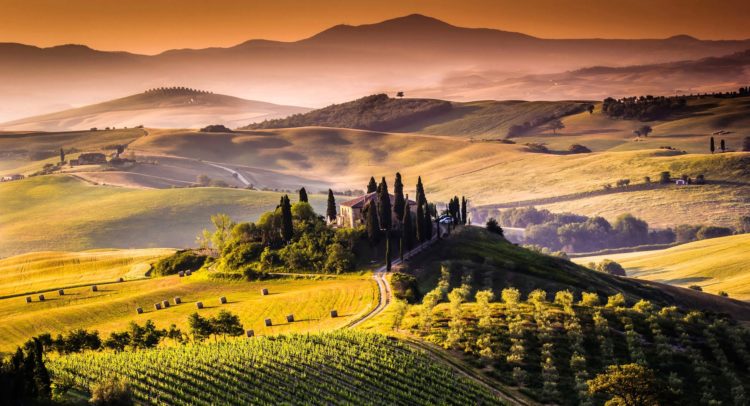Fairytale castles, windy country roads that cross the gentle hills, wild forests, medieval pilgrim trails, ruins of ancient churches and world’s finest wineries – all at once define Tuscany in its vivid details.
Located in central Italy – the region’s capital – Florence, stores some of the world’s most admirable Renaissance art and architecture. With rich and diversified natural landscapes, Tuscany’s geographical land encompasses the rugged Apennine Mountains, the island of Elba’s beaches on the Tyrrhenian Sea and Chianti’s olive groves and vineyards.
Tuscany tops many travelers’ bucket list for plenty of different reasons. In fact the destination is exuberant with varied tourist interests and the difficulty is really where to start. A number of tourists come here in search of fine art, others to explore the extraordinary countryside. Its simple yet wonderful cuisine and wine attract bon vivants from overseas. Walkers enjoy its serene mountain paths, cyclists, its rolling hills and summer vacationers bask its sea coast and islands. And above all, its beautiful Italian language and culture offer a lot to its learners.
This popular tourist destination of Italy has an estimated population of 3.7 million inhabitants and is divided into 10 provinces – Florence, Grosseto, Livorno, Lucca, Massa, Pisa, Pistoia, Prato, Siena and Arezzo. To have a clearer picture, let’s have some details of some of its provinces…
1. Florence:
Based in the heart of Tuscany, Florence is one of Italy’s top cities to visit. As mentioned above, it is an important Renaissance architecture and art center with several excellent museums. Florence’s cathedral, or Duomo, with its famous dome, and its Baptistery are full of architectural wonders that are not to be missed.
2. Pisa:
Galileo’s hometown, Pisa, with all its historical importance, is known throughout the world for its iconic leaning tower. Not only the bell tower but each of its monuments is awe inspiring in its own right. Pisa also boasts of fantastic botanical gardens and some spectacular scenery along the Arno River.
Pisa also boasts of fantastic botanical gardens and some spectacular scenery along the Arno River.
3. Lucca:
With its cobblestone streets and circumferent Renaissance-era wall, Lucca stands distingushed than any other Tuscan provinces.Travelers can enjoy a good walking and cycling options while viewing its historic center at the same time.
Apart from being home to several historic cathedrals, Lucca has several well-preserved towers that grant fabulous views of the city and beyond.
4. Siena:
Marked by its medieval brick buildings, Siena is mainly famous for its large fan-shaped piazza the Piazza del Campo, dominated by its bell tower, the Torre del Mangia. Other than these, the city’s medieval streets are lined with shops and rustic trattoria serving traditional Tuscan cuisine. Maintaining its medieval tradition, Siena’s annual summer horse race, Il Palio, is a must watch event here.
5. Chianti:
Lying between Florence and Siena, Chianti, in particular, is famed for its wine production. Tourists here can taste, buy and even take a tour of their vineyards.
Off many such wineries, the region is verdant in natural beauty with a number of charming villages too. Chianti’s cuntryside is sublime and its wine is excellent.
In Tuscany, the list of such wonderful locations just goes on. In fact, the more you explore the place, the more extraordinary it appears.
Year’s best time to visit Tuscany :
The perfect time to visit Tuscany is between June – August, when it can be hot and humid, especially inland. Many shops and restaurants close in Aug because owners head off for vacations. During Cantine Aperte (May), Tuscan wineries open their doors for tastings and tours. Fireworks, parades and a Renaissance-style football match mark the Feast Day of San Giovanni (Jun 24), Florence’s patron saint. Siena’s medieval Palio horse race takes place on Jul 2 & Aug 16. Tuscany has an enjoyable Winters with occasional snow fall, particularly in the hilly areas.

